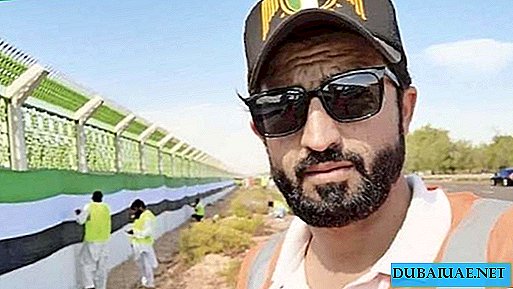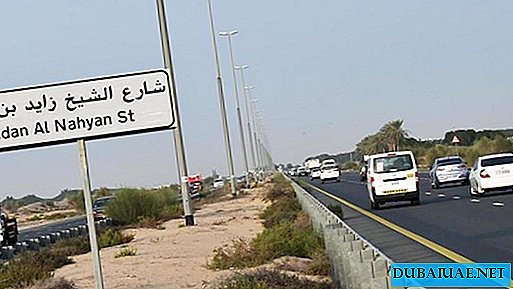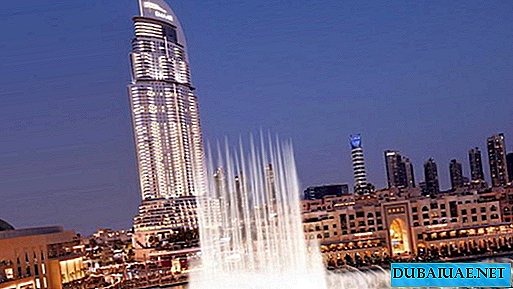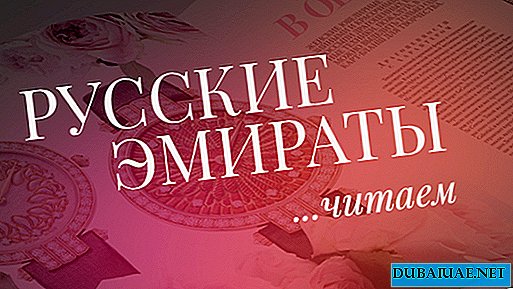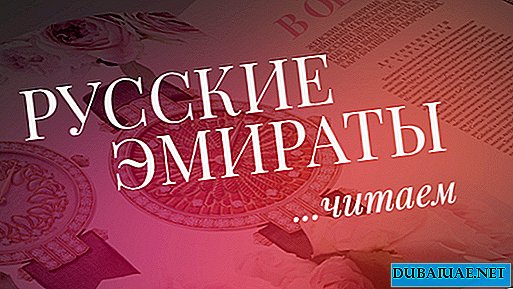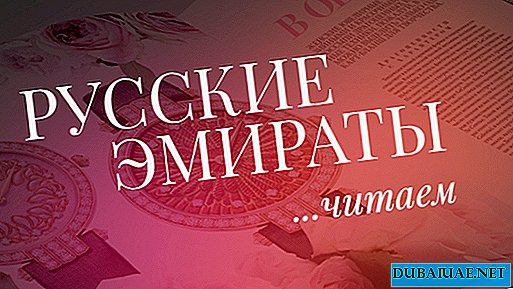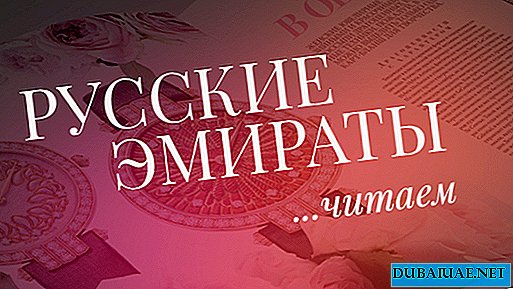The distance of 161 km, which is shared by the emirates of Dubai and Abu Dhabi, we have overcome completely unnoticed thanks to the endless stories of our guide Andrei. From the very beginning of our journey, while still driving along the Dubai roads, one of the best guides in Dubai told us a lot of interesting things about the origin of local names, about the unusual records of today's new buildings and about the history of the country.
Upset Wedding Our acquaintance with the emirate of the capital began with the area of Gantut - the formal border between Abu Dhabi and Dubai. Here, in the shadow of dense thickets on the Gulf coast, cozy bungalows of Al Jazeera resort hid. And then a magnificent and at the same time strange building with a gallery going nowhere appeared before our eyes - an abandoned palace.
Our acquaintance with the emirate of the capital began with the area of Gantut - the formal border between Abu Dhabi and Dubai. Here, in the shadow of dense thickets on the Gulf coast, cozy bungalows of Al Jazeera resort hid. And then a magnificent and at the same time strange building with a gallery going nowhere appeared before our eyes - an abandoned palace.
Once, the two ruling families of Abu Dhabi and Dubai decided to unite by marrying their children. On the border of the two emirates, it was decided to erect a palace in which young people will live. The grandiose construction began to boil. In an extremely short time, not only the palace was erected, but also a gallery connecting the male half of the palace with the female. We carried out all communications and electricity, set up a supply of fresh water. A road was laid from the main road to the palace. In the vicinity of the palace, they planted an orchard and dug an artificial canal, pitched tennis courts, made a pool and sports grounds.
But something did not work out, it went wrong. The wedding did not take place, and both families refused pride of the palace:
And here is another version of how in the middle of the desert this lonely building appeared, in the luxurious chambers of which no one has ever lived.
Over time, after its construction, the ground subsided under the female part of the palace. A giant fissure has spread all over the right wing, growing larger and larger. Then it was decided to demolish the female half, and to support and strengthen the gallery, which now goes into the void, with a loose hill.
Now the abandoned palace is being guarded by two enterprising Pakistanis who, for 10 dirhams, let curious tourists inside. Did they ever dare to imagine that they would walk through the halls of the sheikhs almost like hosts!
Here we are in the city
A visit to the palace left us with a double impression. Meanwhile, the tour was just beginning to gain momentum. The minibus turned around, leaving Gantut, and rushed along a highway with green spaces behind a high fence. We left behind the Bedouin villages where the government of Adu Dhabi gave the nomad families complete ownership of modern villas, freeing them from utility bills and providing free health care and education.
On the island itself, in the city of Abu Dhabi, the capital of the United Arab Emirates and the emirate of the same name, we got across the bridge, thrown over the Al Makta Strait. In turbulent years, the crossing was guarded by 15 warriors who patrol in a small fort under a bridge built in shallow water. Strait is not everywhere everywhere: you can even wade it in some places, as the founders of the city once did.
Today, 700 thousand people live in the capital - this is almost half the total population of the Abu Dhabi emirate. Abu Dhabi Island on top looks like a big irregular triangle, stretching into the sea for 16 km.
The capital has more than 90 thematic fountains, a visit to which was not included
into our program, although each of them is beautiful and unique in its own way.
No less beautiful is the new embankment, recently opened after a grand reconstruction, which immediately became a favorite vacation spot for citizens and tourists. The embankment offers a wonderful view of the 122-meter (slightly higher than Dubai) flagpole with the national flag of the UAE, measuring 20 by 40 meters.
In the capital of the Emirates, there are about a thousand portraits of Sheikh Zayed, including his largest image with an area of slightly less than 500 square meters.
The modern streets of the city, built up with handsome skyscrapers, brought us to the square in front of the Sheraton Hotel. Due to the unusual architecture and colors of the hotel, the Russians call it "Elevator". The square in front of the hotel is decorated with picturesque waterfalls, green lawns and “live” Swiss watches, the “dial” and “case” of which are painted with thousands of flowers. This is the most popular place for photographing and filming among tourists.
Having been at the very top of the hill with the “clock”, wetting our face and hands with water from a transparent reservoir, we set off further and left for Al Ittihad Square. The main attraction of this place is the six sculptural symbols of the Arab world, carved from snow-white stone. We go around them in turn. The Tsar Cannon guards the approaches to the city. The watchtower also belongs to defense structures. Here is the cap that covered the food so that it does not cool. A coffee pot minted on coins in denominations of 1 dirham. A vessel for rose water. Incense incense bowl. The pedestals of some sculptures are bordered by fountains, and the square itself is a pedestrian zone. Families with children like to walk here.
Then, on our way, the famous Old or, as it is also called, the White Fort arose. It was originally built in an open area with an excellent overview of nearby roads. He also became the first government palace of the sheikh dynasty Abu Fall, which owned untold wealth. We walked around the courtyards with many fountains and pools filled with cool water. There were in the fort itself, where they saw the Majlis - halls and living quarters for men, and in the inner fort - on the female half.
"Black cash" of a strange sheikh
Our guide told an interesting story of Sheikh Shahbut from the Abu Fall dynasty. Having raised the economy of the state to the proper height, in foreign policy this sheikh turned out to be an implacable pride. He ruined relations with the government of Dubai, which is why in 1946-1948 both cities were in a state of internecine war. Then he quarreled with the British, violating the oil development agreement and surrendering part of the fishing territories to the Americans.
One of the legends about Shahbut reads as follows. Given the fact that Abu Dhabi was then waiting, then at war, the sheikh was constantly forced to keep on hand the cash necessary for acquiring weapons and hiring soldiers. Therefore, the state treasury was not stored in a bank, but simply in one of the halls of the fort (aka Al Hosn Palace) in bags. And then one day, one far from perfect day, the sheikh, entering the vault, saw that all the bills were eaten away by rats:
Apparently, in this legend there is some truth. One way or another, at the family council, Shahbut was removed from his high post and solemnly dismissed. Such blunders to statesmen were not forgiven. And although the sheikh lost his power, he is still part of the history of Abu Dhabi. His portraits still adorn the walls of the gallery and museum of Al Ain, which is part of the emirate of Abu Dhabi.
Illuminated film The palace in which the sheikh and his family live today can only be seen on the go, without leaving the car. For security reasons, the building is forbidden even to photograph. There was a case when one of the tourists, warned about the ban, nevertheless decided to take a chance and at dusk removed the palace from the car. But the guards noticed the flash of the camera.
The palace in which the sheikh and his family live today can only be seen on the go, without leaving the car. For security reasons, the building is forbidden even to photograph. There was a case when one of the tourists, warned about the ban, nevertheless decided to take a chance and at dusk removed the palace from the car. But the guards noticed the flash of the camera.
Quickly catching up and stopping the car, people in uniform asked to give them the person who took the picture. Tourists, frightened by the menacing appearance and severity of the armed people, amicably pointed to the unfortunate lady who already did not know where to go in this awkward situation. But everything was resolved very safely: the film was illuminated, and the bus with tourists was peacefully released back with a second reminder of the ban.
Modern palace Just as quickly and mobilely, we admired the miracle of modern architecture - the new Emirates Palace Hotel, which is considered the most chic in the Middle East. Entrance into this realm of luxury and taste opens a magnificent arch. The central part of the hotel accepts and accommodates only high-ranking persons and senior political figures. The "mere mortals" (if you can call them that) are located in the east and west wings.
Just as quickly and mobilely, we admired the miracle of modern architecture - the new Emirates Palace Hotel, which is considered the most chic in the Middle East. Entrance into this realm of luxury and taste opens a magnificent arch. The central part of the hotel accepts and accommodates only high-ranking persons and senior political figures. The "mere mortals" (if you can call them that) are located in the east and west wings.
The building rises on the hills and a view of it opens immediately from the intersection of four roads. It is decorated with 114 domes with a diameter of seventeen to three meters. Twenty restaurants, thirty-three kitchens and 300 hotel rooms employ a thousand people of forty nationalities. The building has 140 elevators, it takes about a kilometer in length, and its banquet room is designed for almost three thousand people.
Tired but satisfied
Twilight was already descending into the city when a minibus parked at the last place of our visit - Heritage Village. We looked at how saddler, carpenter, glassblower, blacksmith and weaver work with primitive tools. We watched a huge ox with a heavy burden, got acquainted with the desert irrigation system and visited the historical museum, where they found ancient weapons, tools, catchers, sorters and sellers of pearls, ancient manuscript folios of the Koran, household items and the first photographs of the region.
We were offered to eat in a restaurant, which was comfortably located right on board the Arab dhow boat, which is now "registered" on the Gulf. Once this boat was a schooner of Sheikh Zayed himself, as the photos of the first president hanged everywhere. But when she "grew old" and became unsuitable for boat trips, the sheikh gave it to the capital's municipality, and now the boat serves as a popular sea restaurant.
We tasted Arabic cuisine, tasted fruit and tart Arab coffee. Having finally smoked a hookah, we set off on our way back. Music was playing quietly in the car, Dubai beckoned with bright lights. Travelers were returning home.
Having lived a considerable time in the country, visiting Abu Dhabi regularly, two to three times a month, in just one day, we learned so much new and interesting about the capital that we now recommend that our readers choose the time for such an excursion in one day.
Text: Elena Balina
The tour was kindly provided by the company.
Golden Fish Tours, which also organizes fishing and boat trips on a boat or a comfortable yacht.
Tel .: (04) 331 7107
Mobile: (050) 552 2495




